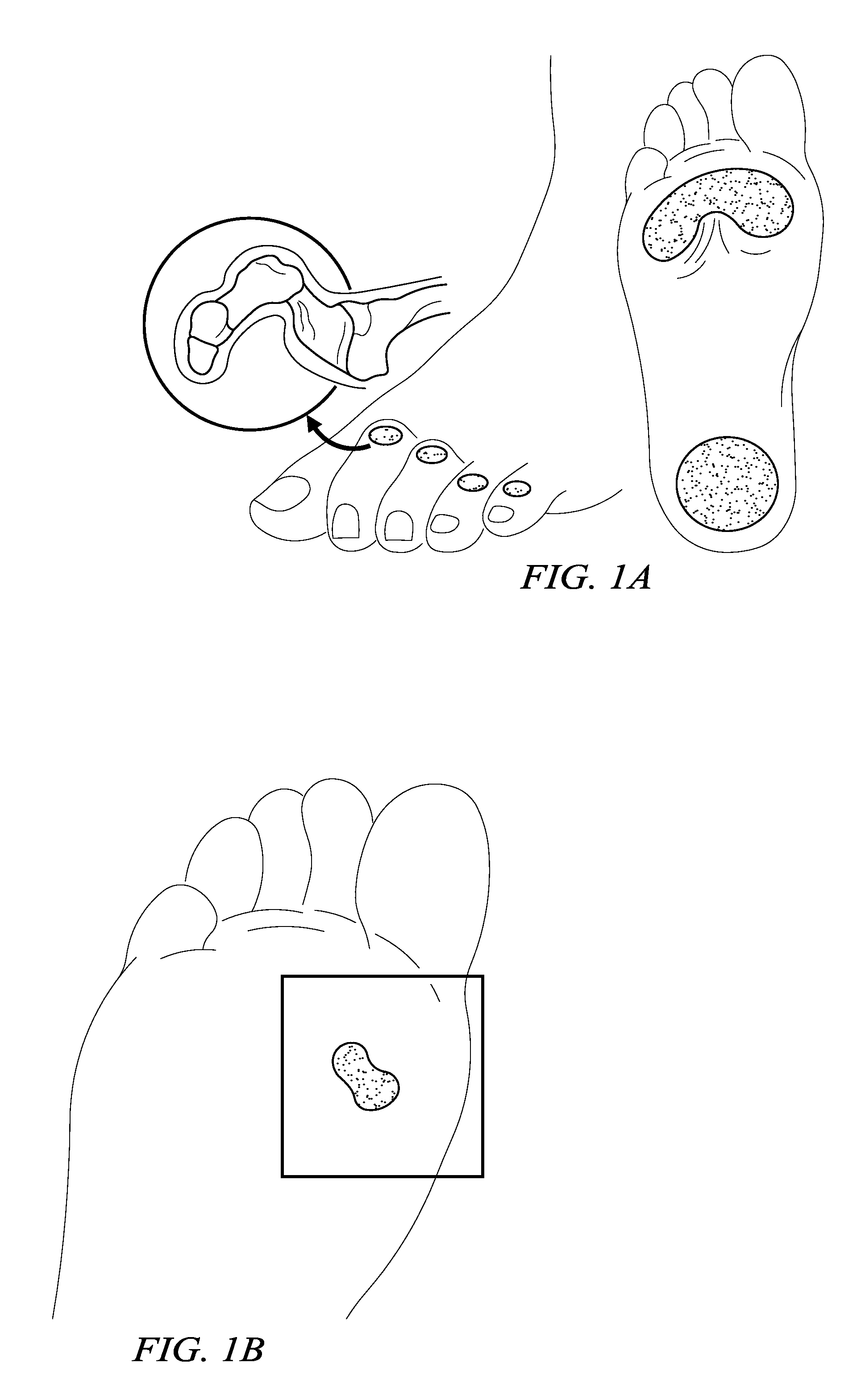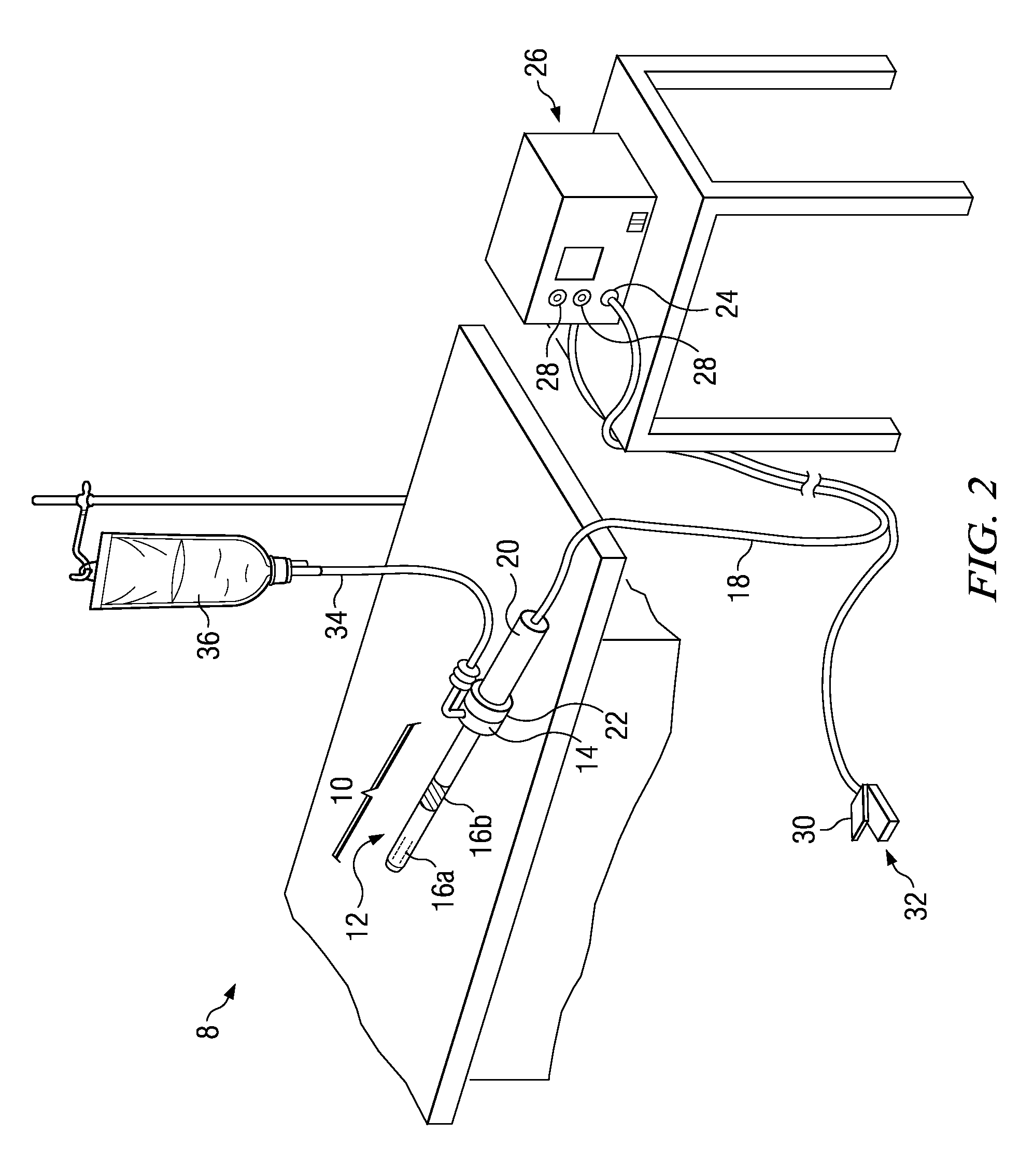[0011]According to one embodiment, the method is an electrosurgical procedure for treating wound tissue, in particular a chronic wound tissue, comprising: positioning an active electrode in close proximity to the wound, the active electrode disposed on a distal end of an electrosurgical probe or shaft; applying a high-frequency
voltage potential difference across the active electrode and a return electrode sufficient to develop a high
electric field intensity associated with a vapor layer
proximate the active electrode wherein the high
electric field intensity stimulates the wound tissue and an expression of at least one healing
mediator in the wound tissue. In certain embodiments, an
electrically conductive fluid is provided
proximate the active electrode, such that the fluid is vaporized and ionized to thereby form a
plasma. Modification of the wound tissue in accordance with the
present method may include perforating tissue on and in the vicinity of the wound, debriding tissue to induce blood flow, debriding
necrotic tissue both on the periphery of the wound bed and within the wound bed itself, removing
biofilm and
bacteria from the wound bed, and applying
plasma and associated RF
electric energy to stimulate or induce a metabolic, biochemical, and / or physiological change in the wound tissue and surrounding tissue, and thereby leverage the body's natural healing response. In other embodiments, the active electrode is inserted into the wound tissue to perforate and remove necrotic or unhealthy tissue, restore blood flow and promote healing.
[0015]With respect to chronic wounds,
ischemia may cause tissue to become inflamed and tissue cells to release inflammatory cytokines, and may also contribute to factors that attract IL-1 interleukins that may damage cells and prevent
cell proliferation. Thus, by altering the expression of cytokines such that there is a decrease in IL-1 and an increase in IL-8, it is suggested that plasma has a role in stimulating a healing response mediated by IL-8 to mediate tissue regeneration, resulting in overall
tissue healing, an a decrease in
inflammation and pain. Increased IL-8 levels attributable to the presently described electrosurgical procedures may also play a role in enhanced wound sterilization as a result of the higher rate of neutrophil attraction to the inflamed chronic
wound site.
Acute infection at a
wound site may lead to chronic wound development, and may further result in
gangrene, loss of the infected limb, and possibly death. Neutrophils produce
reactive oxygen species (ROS) that combat infection and kill
bacteria colonizing a wound bed, such that increased attraction of neutrophils through the
resultant higher IL-8 levels described above may have a sterilizing role through addressing
wound infection and
bacteria levels, as well as limiting the possibility of extended
inflammation in the wound tissue that delays healing and further
damages tissue associated with chronic wounds. Furthermore, the presence of increased levels of IL-8 may assist in counteracting the
fibroblast gene expression characteristic in chronic wounds that is attributed to failure of the
fibroblast to produce an adequate metabolic response to epithelialize the wound.
[0016]Similarly, enhancement of several key
biochemical markers is a significant aspect of proper wound healing response. Growth factors are imperative in successful wound healing, and inadequate
growth factor levels can be a significant contributor in chronic wound formation. For example, in chronic wounds the formation and release of growth factors necessary for wound healing may be under-expressed, prevented or constrained, such that the growth factors are unable to effectively perform their roles in the healing response. By utilizing the effects of electrosurgical
ablation according to the presently described methods to stimulate one or more growth factors such as
vascular endothelial growth factor (VEGF),
insulin-like
growth factor (IGF), and
epidermal growth factor (EGF), the proliferation, migration to the wound bed, and production of new
extracellular matrix components by fibroblasts may be preferably encouraged. Furthermore, treatment of wound tissue with the electrosurgical ablative procedures described herein may also beneficially increase wound bed
sterility as well as promote formation of collagen and
granulation tissue as part of the reepithelialization phase of wound healing.
[0018]The methods described for promoting a wound healing response can result in a variety of biochemical, metabolic, physiological, or anatomical changes that invoke a stabilized healing response to chronic wound tissue. The desired response may be attributed to numerous factors, including
gene expression,
nerve stimulation, stimulation of greater blood flow, collagen growth, alteration of cellular function, treatment site sterilization, or other biochemical or metabolic events that promote healing, repair, and regeneration of injured tissue. In some embodiments, these induced changes may include increased anabolic tissue cellular response including
angiogenesis,
fibroblast proliferation, and stabilized remodeling of extra-cellular matrices. The changes may further include increased
nerve stimulation,
cell metabolism, increased collagen synthesis in fibroblasts, transformation of fibroblasts to myofibroblasts, increased capillary formation with enhanced
microcirculation, and / or enhanced clearance of noxious substances associated with the
inflammatory response. In other embodiments, the wound healing response may include an
increased blood flow to, and vascularization or
revascularization of, the treated wound region, thereby promoting healing and regeneration of injured tissue. In yet other embodiments, the wound healing response may include stimulating the growth of new collagen in the treatment area.
 Login to View More
Login to View More  Login to View More
Login to View More 


